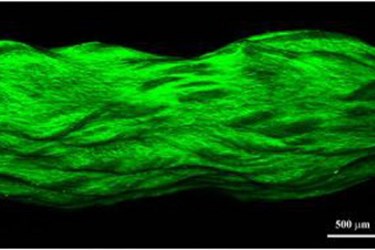Scientists Devise New Method For Growing Replacement Tendons
By Joel Lindsey

Researchers at Case Western Reserve University have devised a way to grow replacement tendons using a combination of collagen and stem cells, a development they say could prove beneficial in a number of medical applications.
“This is a concept that works on a lab bench,” Ozan Akkus, professor of mechanical and aerospace engineering at Case Western, said in a press release. Akkus is in charge of the research project and recently won a $1.7 million grant from the National Institutes of Health to continue his work. “We will refine the concept and test the validity on an animal model. Following completion of that, we may be in position for clinical applications.”
In order to build replacement tendons, Akkus and his research team started by growing collagen, a substance found throughout the human body and is therefore readily accepted by the immune system when used in implant material. Because collagen is typically loose and weak when reconstituted in a laboratory, Akkus used electrical currents to align the substance into dense threads that could be manufactured in bulk. These collagen threads were strong enough on their own to be used in sutures and simple repairs of damaged tendons, according to the press release.
“A simple detachment, doctors suture back in place. But if the body or bulk of the tendon is damaged and there is not enough tendon to reattach, we need to regenerate bulk volume of the tendon,” Akkus said.
In such cases — when more tendon material is necessary — Akkus and his team had to add the extra step of placing adult mesenchymal stem cells on the aligned collagen, where they grew into tendon cells and eventually tissue.
Having demonstrated the viability of this approach, Akkus and his team plan on continuing to study why stem cells differentiate toward forming tendon tissue, as well as exploring methods to induce more effective differentiation.
The researchers also believe that the general approaches they have devised for growing sturdy collagen and tendon tissue could be used to grow other types of biomaterial as well. For example, they plan on testing whether mesenchymal stem cells could be used to grow reparative bone marrow when coupled with a collagen scaffold inside either in vitro or in actual bone. Additionally, sheets of lab-grown collagen could possibly be grown inside molds of noses or ears to serve as replacements for patients who have suffered traumatic injuries or who have lost body parts to tumors
Image credit: Mousa Younesi
